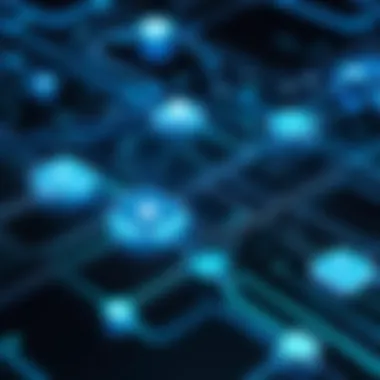IoT Challenges: Navigating a Complex Landscape


Intro
The Internet of Things (IoT) represents a profound shift in how we interact with technology. It connects devices, systems, and services, allowing for seamless communication. However, the rapid adoption of IoT also brings a set of complex challenges that stakeholders must navigate. These challenges span technical issues, security concerns, and socio-economic implications. It is vital to understand these hurdles to optimize the use of IoT technology for future developments.
Through this discussion, we will explore prominent barriers such as aging infrastructure and interoperability issues. The subsequent sections will analyze the implications of regulatory frameworks, market dynamics, and the technological landscape that shapes IoT today. This article aims to provide valuable insights for industry professionals, researchers, and policymakers alike.
Let’s delve deeper into what these challenges entail.
Preface to IoT Challenges
The Internet of Things (IoT) is revolutionizing the way we interact with technology. It enables devices to communicate and share data seamlessly, which can greatly enhance our daily lives and improve efficiency in various sectors. However, with this rapid adoption come significant challenges that need to be addressed. Understanding these challenges is crucial for developers, policymakers, and consumers alike. This section aims to outline the main issues faced in the IoT landscape and underline the importance of tackling them head-on.
Definition of the Internet of Things
The Internet of Things refers to a network of interconnected devices that can collect and exchange data. This can include everything from smart home appliances like thermostats and lights to industrial machines and healthcare devices. The aim is to create a more integrated and automated environment that can operate with minimal human intervention. In essence, IoT transforms ordinary objects into smart devices, facilitating improved communication and functionality.
Significance of Addressing Challenges
Addressing the challenges in IoT is not just a technical necessity; it is a matter of ensuring that we can maximize the benefits of this technology. When challenges such as interoperability, data management, and security are ignored, the potential of IoT diminishes significantly. Consider the following points:
- Trust in Technology: Without effective solutions for security and privacy concerns, users may be reluctant to adopt IoT devices.
- Global Integration: The lack of standardized protocols hinders device interoperability, complicating integration and increasing costs.
- Sustainability: Challenges in data management can lead to inefficiencies that negate the environmental benefits IoT promises.
By highlighting these elements, we can understand that navigating the complexities of IoT's challenges is essential for fostering innovation and creating a safe, efficient, and sustainable digital landscape.
Technological Challenges in IoT
The Internet of Things (IoT) stands at the intersection of numerous technological hurdles. Addressing these challenges is crucial for the successful implementation and growth of IoT systems. Technological challenges in IoT encompass aspects like interoperability, scalability, and data management, affecting both the adoption and efficiency of IoT solutions. These issues must be navigated effectively to leverage IoT's potential.
Interoperability Issues
Importance of Communication Standards
Communication standards are essential for the seamless operation of IoT devices. They ensure devices from different manufacturers can work together without conflict. This standardization minimizes compatibility issues and allows for easier system integration. The key characteristic of communication standards is their ability to provide a common language for devices to interact. Utilizing these standards promotes efficiency and reduces development time, making it a favored choice in the IoT landscape.
However, the unique feature of having multiple competing standards can lead to fragmentation. This can create challenges for developers who must choose a standard that may not be universally accepted, leading to potential barriers in device integration.
Impact on Device Integration
Device integration is crucial for a fully functional IoT ecosystem. The ability for devices to communicate enhances the overall performance and utility of IoT systems. A significant aspect of this integration is the reliance on robust communication protocols. Integration supports the efficient flow of data between devices, thereby improving functionality. The highlighted characteristic is the smooth operation and increased reliability of integrated systems. This approach fosters a comprehensive environment where devices can operate in harmony.
However, the unique feature of varied device capabilities may hinder integration attempts. Different manufacturers often have different support for protocols, which may complicate the process. This leads to advantages in functionality but poses risks in compatibility.
Scalability Concerns
Challenges in Managing Device Volume
As the number of IoT devices increases, managing this volume becomes a significant concern. Device management is integral to maintaining the performance and security of IoT networks. The challenge lies in ensuring that the systems in place can support growing numbers efficiently. An essential characteristic of managing device volumes is the potential for overload. High traffic can lead to latency, affecting responsiveness.
When looking closely, this serves as a beneficial approach to highlight the importance of effective device management systems that can handle rapid scalability. However, the unique aspect is that as device numbers increase, so do the complexities of maintaining these systems, potentially leading to system failures or reduced performance.
Network Infrastructure Limitations


Network infrastructure plays a vital role in the IoT ecosystem. Proper infrastructure is necessary to accommodate the increasing data and device demands. Key aspects of network limitations include bandwidth constraints and latency issues. These can adversely affect data transmission and real-time interactions between devices.
Understanding the infrastructure challenges is beneficial because it emphasizes the need for robust network solutions. Addressing these issues can prevent bottlenecks and enhance reliability. However, the unique feature to note is that upgrading infrastructure to meet the needs of IoT can be a costly and complex process, posing further challenges for many organizations.
Data Management Difficulties
Data Volume Challenges
The volume of data produced by IoT devices is staggering. Managing this data effectively is crucial for extracting valuable insights. The essential characteristic of these challenges is the sheer scale of incoming data, which can overwhelm processing systems. Highlighting data volume is an important aspect because it showcases the need for efficient data management strategies. Technologies such as edge computing can mitigate these challenges by processing data closer to the source.
A unique feature of this data deluge is the risk of data loss or corruption during transfer. Ensuring data integrity while handling large volumes is paramount, presenting yet another complexity in the IoT landscape.
Real-Time Processing Requirements
Real-time processing is necessary for many IoT applications, especially in fields like healthcare and smart cities. The need for immediate data analysis is critical to functionality. Real-time processing emphasizes the importance of quick decision-making capabilities. The focus on this characteristic highlights the necessity for advanced algorithms and processing capabilities in devices.
An important feature to mention is that while real-time processing is advantageous, it can be resource-intensive. This may lead to increased energy consumption, which is a disadvantage for battery-operated devices. Balancing efficiency and performance remains a challenge for the future of IoT.
Security Challenges in IoT
Security challenges in the Internet of Things (IoT) are crucial in understanding the entire landscape. As devices connect and communicate, they create more entry points for cyber threats. Addressing these issues is not just a technical necessity but a matter of ensuring user trust and promoting widespread adoption of IoT technologies. Securing the collection, transmission, and storage of data is essential for safeguarding users’ information and the integrity of connected systems.
Cybersecurity Threats
Vulnerability of Connected Devices
Connected devices often have weaknesses that hackers exploit. Many IoT devices are designed with limited consideration for security, focusing instead on cost and functionality. This results in flaws that may not be immediately visible. The increasing number of devices on networks intensifies this risk. Each added device can introduce new vulnerabilities. It's important to consider that many users do not keep their devices updated. An outdated device can be akin to an unlocked door.
Some devices may also use default passwords, which can be easily guessed. This characteristic makes these devices particularly attractive targets for cybercriminals. The convenient nature of these devices often overshadows their security implications. The advantages include ease of use and rapid deployment, but these factors can lead to significant risks without proper oversight.
Despite these vulnerabilities, the interconnected nature of IoT can offer benefits by improving efficiencies in various domains. However, the risks must be adequately mitigated to ensure safety.
Impact of Data Breaches
Data breaches can have severe consequences for businesses and individuals. When connected devices are compromised, they can lead to unauthorized access to sensitive information. The key characteristic of data breaches is their ability to affect not just the immediate systems but also the entire network, causing systemic failures. Their potential for widespread damage signifies why they are an alarming consideration in this article.
Breaches can result in financial loss, reputational damage, and decreased consumer confidence. Furthermore, the unique feature of these breaches lies in their unpredictability. It is often difficult to ascertain the point of breach or the extent of data loss. The advantages of connected technology can quickly turn into liabilities if security measures are not prioritized, leading to a reactive rather than proactive stance against threats.
Privacy Concerns
Privacy is a significant consideration in the conversation about IoT security. As devices collect data, there are implications regarding how that data is handled and shared. Ensuring user privacy is just as vital as securing the devices themselves. Mismanagement of personal information can lead to severe repercussions for individuals and companies alike.
User Data Protection
User data protection is essential to maintain trust between users and IoT systems. Effective protection strategies must include data encryption and regular assessments of security protocols. This characteristic highlights the importance of integrating robust security measures during the device design and usage phases. In this article, it reflects a beneficial approach to addressing the privacy issues in IoT.
The unique feature of user data protection is its dual role. Not only does it safeguard sensitive information, but it also serves as a competitive advantage for companies that promote strong data practices. Users are likely to favor products that emphasize their privacy protection. Hence, while the implementation of such measures might require investment, the long-term benefits can far outweigh these costs in terms of brand loyalty and user retention.
Regulatory Compliance Issues
Regulatory compliance issues are another layer to consider in IoT privacy concerns. As governments introduce new laws to protect privacy, companies must adapt their practices accordingly. This aspect is essential since non-compliance can lead to hefty fines and legal challenges, making it a critical point for discussion.


The key characteristic of these issues is their constant evolution. Regulations tend to vary significantly between regions and change over time. This creates challenges for global companies trying to maintain compliance across different jurisdictions. In this article, it underscores the need for a comprehensive understanding of regulatory frameworks.
The unique dimension of compliance issues is their implication for innovation. Striking a balance between meeting regulatory requirements and fostering innovation is not straightforward. Compliance can create constraints that inhibit development, but it can also encourage better practices and higher standards in IoT design and usage. Organizations must navigate this landscape carefully, ensuring that they respect user privacy while still advancing technology.
Regulatory and Compliance Challenges
As IoT technology grows, regulatory and compliance challenges emerge, influencing the development and deployment of these systems. Regulations ensure that devices function safely while protecting users' rights. Addressing these challenges is critical for fostering trust, ensuring safety, and supporting innovation in IoT.
Lack of Standardized Regulations
The IoT landscape is marked by a lack of standardized regulations. Different countries and regions have varying rules, which creates confusion in the industry. This disparity complicates product development as companies have to adjust their technologies to comply with multiple regulations. Moreover, the absence of a unifying regulatory framework can impede collaborations among IoT ecosystem players.
While some regions have started to implement guidelines, they often focus on specific sectors like healthcare or transportation. This narrow approach leaves gaps in regulations across other sectors that also utilize IoT technologies.
Evolving Legal Frameworks
Challenges in Global Compliance
Global compliance presents significant obstacles for IoT companies. Each jurisdiction has distinct laws and requirements, which complicate international expansion for businesses. Companies must invest considerable resources to understand and adhere to the diverse compliance mandates in different regions. The key characteristic of these compliance challenges is their complexity, which can be daunting.
The unique feature of global compliance is that failing to adhere can lead to hefty fines or legal repercussions. Companies that neglect these aspects may face reputational damage, making it critical to navigate the compliance landscape carefully. This situation adds significant burden on resources, making it less attractive for smaller entities in IoT.
Implications for Innovation
The implications for innovation stemming from regulatory challenges are profound. Regulations can either stimulate innovation by providing clear guidelines or stifle it due to excessive bureaucracy. A well-defined regulatory environment can encourage investment and drive advancements in IoT technologies. However, when regulations are unclear or overly restrictive, they can hinder the development of new solutions.
One unique aspect of this challenge is the balance that needs to be struck between protecting consumers and allowing businesses to innovate. Excessive regulations can lead to a slow adoption of new technologies. Therefore, striking a balance is essential. For the IoT industry, clear yet flexible regulations can serve as a catalyst for growth and innovation.
"Without proper regulations, the future of IoT could be at risk, hindering innovation and implementation."
Social and Economic Challenges
The rapid evolution of the Internet of Things (IoT) manifests not only in technical obstacles but also in pressing social and economic challenges. These issues play a vital role in shaping the future landscape of IoT. Understanding these challenges is essential for stakeholders aiming to harness the benefits of IoT, as they directly affect labor markets and accessibility to technology.
Impact on Employment
Automation and Job Displacement
Automation influenced by IoT has sparked significant discussions regarding job displacement. The integration of smart devices streamlines operations, enhancing efficiency but results in reduced labor needs. for instance, industries like manufacturing and services increasingly rely on robotics and AI-driven solutions, leading to a gap in traditional job roles.
While this trend can lead to increased productivity and reduced operational costs, it raises valid concerns about future employment. Many argue that the speed of automation outpaces the adaptation of the workforce. Hence, the core of this discussion focuses on the balance between technology advancement and its social impact.
Skills Gap and Workforce Adaptation
The skills gap presents another significant challenge in the IoT landscape. As traditional jobs fade, new roles requiring advanced technical skills emerge. This shift demands urgent investment in education and training programs to equip the workforce with necessary competencies. Skilled professionals in fields like data analysis, cybersecurity, and IoT device management are in high demand.
However, the transition is not seamless. Many existing workers find it challenging to adapt to these rapidly changing requirements. Organizations must consider how to facilitate reskilling initiatives to bridge the skills gap and ensure the workforce remains relevant.
Digital Divide Issues
Access to IoT Technologies


Access to IoT technologies is a major concern that reflects the digital divide. In many regions, especially in developing countries, the lack of infrastructure hinders effective adoption of IoT. This disparity means that while some benefit from advanced technologies, others remain disconnected, widening the socio-economic gap.
Addressing this issue requires significant investment from both public and private sectors to improve infrastructure. Initiatives that promote wider access can enhance overall technological equity within communities, ensuring that benefits of IoT are inclusive rather than exclusive.
Socio-Economic Disparities
Socio-economic disparities significantly impact the adoption of IoT. Communities with higher economic stability tend to adopt IoT solutions sooner than those struggling economically. This imbalance not only slows down innovation in less affluent areas but also reinforces existing inequalities.
It is crucial to explore ways to mitigate these disparities. Collaborations between governments, non-profits, and private entities can lead to frameworks that support underserved communities. Fostering an environment where all can participate in the IoT revolution benefits societies as a whole, elevating standards of living and creating opportunities.
Future Directions and Solutions
The exploration of future directions and solutions is crucial for understanding how to overcome the challenges faced by the Internet of Things. This section aims to shed light on technological innovations and policy recommendations that can enhance the adoption and efficacy of IoT technologies. The intersection of technology and policy will be examined for its implications in shaping a sustainable IoT ecosystem.
Technological Innovations
Emerging Technologies in IoT
Emerging technologies in IoT significantly influence how devices communicate and function. One key technological advance is the use of artificial intelligence (AI) and machine learning (ML) to improve data analysis and operational efficiency. As devices generate vast amounts of data, AI can automate decision-making and predictive analytics. This reduces latency and enhances responsiveness.
The beneficial characteristic of these technologies is their ability to learn from data patterns. It empowers devices to adapt to user preferences over time. The unique feature here is the seamless integration of AI with IoT platforms, facilitating smarter interactions. However, it also raises questions about data privacy and the potential bias in AI algorithms.
Improving Security and Interoperability
Improving security and interoperability is essential for the sustainable growth of IoT. Well-defined security frameworks can protect connected devices from threats. Robust encryption and authentication protocols will be increasingly critical as networks expand. Each device needs to communicate effectively and securely, which highlights the need for standardized protocols.
The key characteristic of this approach is its all-encompassing nature. By focusing on both security and communication standards, it fosters a secure environment for data sharing. A unique aspect of improving interoperability lies in adopting open standards that facilitate device compatibility, thus encouraging innovation and collaboration. However, implementing these standards poses challenges in industry alignment and compliance.
Policy Recommendations
Developing Regulatory Standards
Developing regulatory standards plays a pivotal role in creating a conducive environment for IoT growth. Standardization can help mitigate risks by ensuring minimum requirements for data protection and device security. A common framework can also enhance consumer trust in IoT devices.
The beneficial characteristic of regulatory standards is their ability to foster collaboration among stakeholders. When everyone adheres to the same rules, it builds a cohesive market structure. The unique feature is the adaptability of these standards, which can evolve with technological advancements. The downside may be the slow pace of regulatory adaptation to rapid technology developments.
Encouraging Public-Private Partnerships
Encouraging public-private partnerships is vital for addressing the multifaceted challenges in the IoT landscape. Such collaborations can mobilize resources and expertise from both sectors, accelerating innovation and infrastructure development. By leveraging the strengths of government and industry, stakeholders can create a robust ecosystem for IoT.
The key characteristic of these partnerships is their ability to facilitate knowledge sharing and expedite deployment of new technologies. They can lead to more effective policies and novel solutions tailored to specific community needs. The unique aspect is the blended approach to funding and research, though it requires careful management to align interests.
Epilogue
In the realm of the Internet of Things, the challenges we face are both significant and multifaceted. The conclusion serves as a crucial reflection on the complexities discussed throughout this article. It is essential to recognize the intertwined nature of technological, security, and socio-economic issues that accompany IoT adoption. Only by understanding these elements can stakeholders effectively strategize and move forward.
Summary of Key Challenges
The key challenges identified in this analysis encapsulate the hurdles that must be navigated to ensure successful IoT implementation. They include:
- Technological Challenges: Interoperability issues hinder device integration, while scalability concerns limit infrastructure capacity as device numbers increase. Additionally, managing vast quantities of data and meeting real-time processing demands pose further difficulties.
- Security Challenges: Cybersecurity threats proliferate as connected devices become prevalent. Vulnerabilities can lead to significant data breaches, which impact user trust and drive regulatory scrutiny. Furthermore, privacy concerns necessitate improved data protection practices in compliance with evolving legal standards.
- Regulatory and Compliance Challenges: The lack of standardized regulations and the complexity of compliance across different jurisdictions complicate the regulatory landscape. Innovation can be stifled without clear frameworks to support growth.
- Social and Economic Challenges: The effects on employment due to automation raise concerns about job displacement. Furthermore, the digital divide highlights significant socio-economic disparities in accessing IoT technologies.
Call to Action for Stakeholders
For stakeholders in the IoT ecosystem—be they developers, policymakers, or industry leaders—the call to action is clear. There is a pressing need for collaboration and innovation among all parties involved.
- Foster public-private partnerships to bridge the gap in technology deployment and regulatory development.
- Work towards developing standardized regulations that can guide global compliance while promoting innovation.
- Invest in education and workforce training programs to address the skills gap associated with the transition to highly automated environments.
By taking these actions, stakeholders can better prepare to navigate the complex landscape of IoT, turning challenges into opportunities that enhance the potential of this transformative technology.



